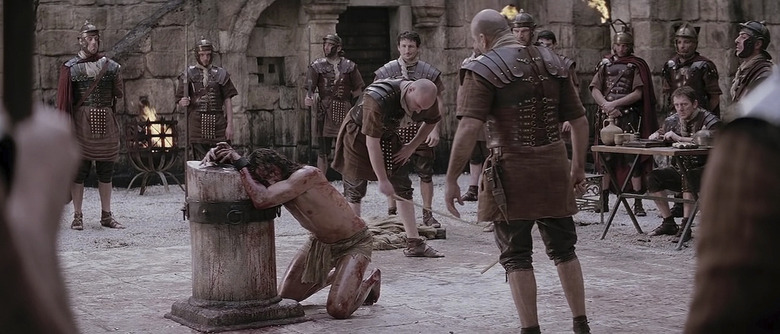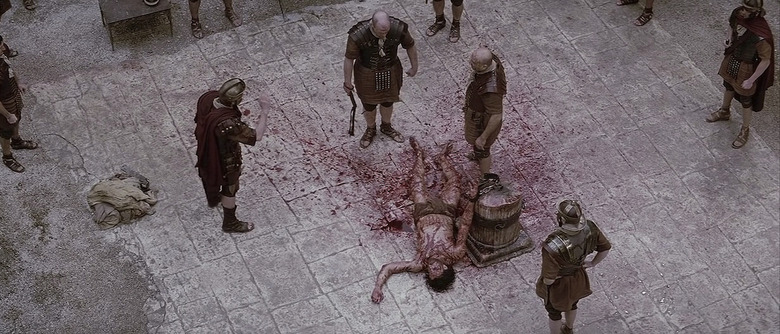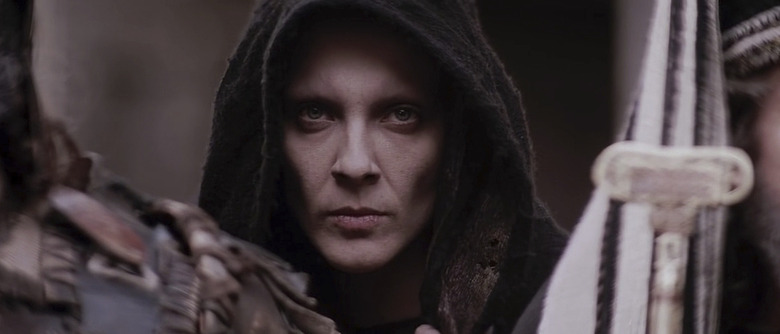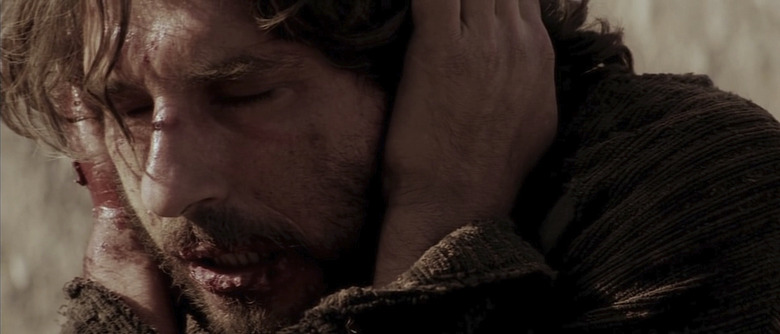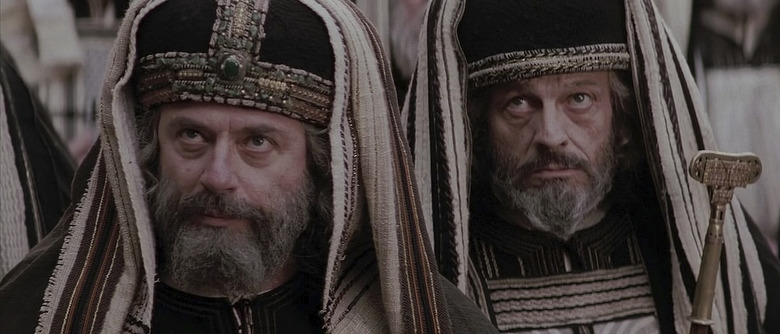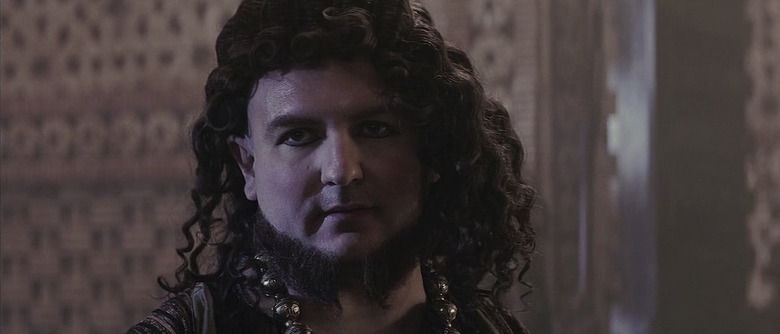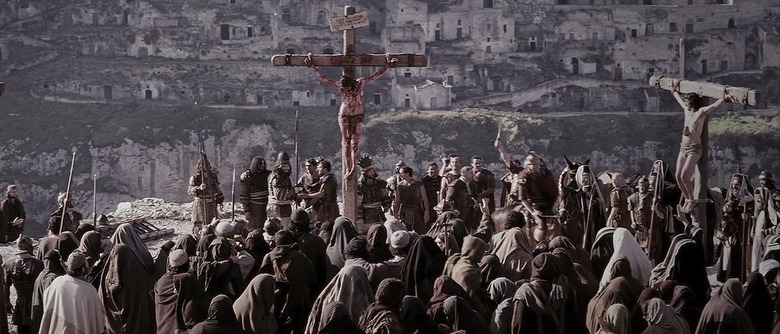'The Passion Of The Christ' At 15: Untangling The Crown Of Thorns Of A Divisive Religious Blockbuster
Some fast facts: Deadpool came close to unseating it, but after fifteen years, the all-time highest-grossing R-rated movie in the U.S. is still a subtitled film about the last hours of Jesus Christ's life. Another comic book movie, Black Panther, has since surpassed it as #1, but for over a decade, The Passion of the Christ was also the highest-grossing February movie in the U.S.
The month of February used to be more of a dumping ground for low-profile movie releases, so when The Passion of the Christ hit theaters on February 25, 2004, it didn't look poised to become a certified blockbuster. For Christians, it was a holy day—Ash Wednesday, the first day of Lent. For everyone else, it was just hump day, a random Wednesday when they might happen to see Xtians walking around with ash crosses on their foreheads.
To say that The Passion of the Christ was and is a contentious film would be an understatement. Entertainment Weekly once ranked it as the most controversial movie of all time, just ahead of Stanley Kubrick's A Clockwork Orange, a film that helped bring the word "ultra-violence" into the cinematic lexicon with its depiction of a disturbing home invasion set to the tune of "Singin' in the Rain." In a way, that juxtaposition is fitting, because while Jim Caviezel receives top billing as Jesus, ultra-violence is the real star of The Passion of the Christ. The film's divisiveness goes beyond its horror-movie shock tactics, however, to what EW called "a culture-war firestorm unrivaled in Hollywood history."
It's the film that opened up the floodgates on the niche market of faith-based movies. The question is: outside the usual echo chambers, below all the noise, how does The Passion of the Christ hold up fifteen years later?
Talking about The Passion of the Christ raises a whole host of issues; long-standing charges of antisemitism against the film are just one of those. The can of worms this movie explodes is almost bigger and more unwieldy than any one analysis can contain.
Let's try, anyway. To keep this 15th-anniversary revisit orderly and manageable, we'll limit it to three main areas of discussion, spread out over several sections. First, we'll tackle the film's violence through a detailed examination of one set piece, namely, the extended whipping torture of Jesus at the hands of the Romans, which arguably provides the film's most memorable, discomfiting scene.
Then, we'll address accuracy and interpretation: how the film builds the illusion of historicity and of fidelity to its primary source material, the Bible, while also bringing in outside influences and giving itself leeway to take a great deal of artistic license with various elements. The driving question here is, how and why does The Passion of the Christ choose to emphasize certain things, and are there times when the film's focus is inappropriate?
Finally, we'll touch on how the film's legacy dovetailed with the real-life toxicity of director Mel Gibson's personal scandals. The Passion of the Christ marked the beginning of a new ignominious phase in Gibson's career, one that would see the former Hollywood heartthrob become a highly polarizing figure—in some ways, yet another emblem of that ongoing culture war in America. Stoning Gibson to death isn't on the agenda here, but The Passion of the Christ is one of those movies where separating the art from the artist is virtually impossible in any honest appraisal, simply because of how the film has lived in public perception these last fifteen years.
Breaking Down the Scourging Scene
In The Passion of the Christ, Jesus endures unrelenting brutality, so much so that it's not hard to see why the film's detractors might label it "Christian torture porn." At the same time, if you venture onto YouTube, let's say, and start reading the most upvoted comments below clips from the movie, it can be like peeking into an old-time big-tent revival, where worshipful strangers are giving praise to Jesus and sharing testimonials of how their lives changed after watching The Passion of the Christ. It's a religious film, yes, but it's also clear that this movie was a downright religious experience for some people.
Just to let you know where I'm coming from — my background and bias — I'm a pre-seminary dropout turned teacher who moonlights as a movie blogger. Around the turn-of-the-millennium, after Saint Augustine's Confessions blew my 18-year-old mind, I attended a private Lutheran college with an eye toward becoming a pastor. Even though I ultimately decided against pursuing that vocation, I still attend a small Lutheran church and I've probably studied the New Testament of the Bible more than the average layperson.
Anyway, that's the perspective that I'm bringing to The Passion of the Christ. It's a different perspective, I imagine, than you're apt to find on most mainstream movie blogs. Yet even with that point-of-view, I can see that The Passion of the Christ does show literal torture. Unless you're a gore hound, it's one of the most graphic films you're ever likely to see. The real question is whether the "graphic," in this case, reaches a wanton pornographic level. Is it truly torture porn or something else?
Let's address that question right off the bat with an in-depth (and indeed, obsessive-compulsive) analysis of the whipping, or scourging, scene, which easily rates as the most prolonged scene of over-the-top bloodshed in the movie. One of the most frequent criticisms of The Passion of the Christ is that it is needlessly, excessively violent. How does that criticism bear out when you attempt to quantify the cruelty?
More so than the climactic crucifixion, it's the whipping scene that really serves as the sadistic centerpiece of The Passion of the Christ. That's not to say, necessarily, that the film itself is sadistic (though detractors would argue that it certainly is). It's just to say that the film unquestionably depicts the gleeful sadism of Roman soldiers as they rip the flesh off Christ's back and as we hear every squishy strike of their whips. These soldiers chain Jesus to a post in a courtyard, gather around his back like a pack of hyenas, and set about lashing him mercilessly.
If you thought they were going to stop at the standard 39 lashes, you'd be wrong. Because I have OCD (it's a problem), I actually went back and tried to count the number of times they whip Jesus in The Passion of the Christ.
What makes this a slight challenge is that the subtitles drop out during the whipping scene. Gibson originally wanted to make The Passion of the Christ as a foreign-language film with no subtitles. He eventually compromised and included some, but there are still other parts where he left the subtitles out in favor of trying to tell the story in a raw visual manner.
During the first round of lashes with stick whips, Jesus receives 32 lashes, by my count. Then, one of the soldiers breaks out a flagellum, or cat o' nine tails whip, demonstrating in an unforgettable fashion how this particular metal-tipped torture instrument can rip wood off tables.
The count starts over. On the tenth flagellum lash, the whip rips a big chunk of flesh off of Christ's side. For a while, the whipping fades to the background, making it harder to keep count, but if you watch and rewatch the scene the way I did, you'll soon find yourself learning to recognize Latin numbers. This makes it easier to do course-corrections with counting.
At one point, while Mary, mother of Jesus, and Mary Magdalene, are off weeping, away from the sight of the whipping, the camera pans over to John, the beloved disciple. Right at this moment, the voice of the counting Roman can distinctly be heard saying, "Quadraginta!" (Latin for "40") in the background.
That's 40 lashes in the second round, plus 32 in the first round, for a grand total of 72 lashes ... and we're still not done yet.
Whence This Whipping Frenzy?
Believe it or not, after 72 lashes, the whipping continues, but at this point, I'm no longer sure I trust my own ears as a counter. Was that one lash with an echo I just heard, or two lashes in swift succession? I thought we were up to a higher number, but then it sounded like the voice in the background said, "...septem!" (Latin for "7," in which case, the count would be 47).
Either way, after about 50 lashes, give or take (plus 32 on the first round, for an approximate total of 82), the lead Roman torturer holds up his hand dramatically. He gestures for them to flip Jesus over onto his back. Now they commence whipping Jesus on the front of his body.
This is the third round of whipping. As it gets underway, the scene sort of shifts into montage mode. It's entering into a more dreamlike, or nightmarish, flow. Maybe that's how the whole protracted whipping bout should be read: not as an accurate count, but as a nightmare impression of Christ's torture.
As if to show how awful and strange this nightmare can truly be, Satan shows up with a demon baby right around this point. Everyone in the crowd is standing face forward, mesmerized by the scourging, but Satan glides sideways through the crowd. The Devil, as depicted in The Passion of the Christ, is androgynous (more about that later) and he/she is holding "a 40-year-old 'baby'," as Gibson termed it.
"What's up with the ugly baby?" asks Christianity Today. People were writing into the site back in 2004. Even Christians were confused by this bizarre moment in the movie with the leering and grinning demon baby—whose presence in the arms of Satan inverts the image of Mary holding an infant Jesus. It's an inversion meant to provoke a visceral reaction in the audience and to show how there are evil cosmic forces aligned against the good ones in this story.
If nothing else, it distracts from counting the lashes.
After they start whipping Jesus on the front of his body, the count starts at "Octo!" (Latin for "8"), so I'm thinking that verifies we were at 47 before and now we're at 48 with the flagellum. We then get 15 or 16 more lashes before the scene transitions into a flashback. That puts us at a total of 63 or 64 lashes with the flagellum, plus 32 lashes from the first round with the stick whips, for a grand total of 95-96 lashes, give or take.
One more lash comes after the flashback ends. Then one of the senior-ranking Romans, Abenader, comes in and finally breaks up the whipping.
I'm going to go out on a limb here and give 96 lashes as my conservative estimate for how many times Jesus gets whipped during the scourging scene in The Passion of the Christ.
It's sort of a make-or-break number. If you're willing to go along with that number, then you might be willing to go along with the movie. If you think that number is wildly gratuitous, then you might not.
40 lashes maximum, minus one, was the standard according to ancient Hebrew law. However, since the Romans were the ones doing the whipping, and since biblical accounts hold that Jesus wasn't strong enough to carry the cross on his own, we really have no way of knowing if Gibson's multiplication of that number gels with the event that Christians believe happened in the 1st century AD. It's an interpretation of what might have happened—perhaps a liberal one, and yes, perhaps a sadistic one.
At the very least, the viewer is left watching this scene and wondering: how much punishment can the human body really take? Shouldn't Jesus have bled to death by now? How is he still alive? Is the movie just asking us to believe that he's superhuman, the Son of God, and therefore able to sustain his frail mortal body through divine power? Or could a normal human being actually survive the same impossible level of agony?
All throughout the movie, the angry mob smacks Jesus around. It beats him till he's broken and bloody and can only flop to the ground like a rag doll. By the end, his face is a red mask of pulp.
Is the endless succession of blows meant to be a visual expression of every sin he's ever felt, every betrayal, from every person throughout human history? Or is it meant to be more literal, more tangible, less metaphysical, than that?
Is Gibson wielding violence as a sick provocation or a spiritual one? Whence this whipping frenzy in The Passion of the Christ?
What makes that question so much more mysterious is the fact that everything we've covered in these last two sections — this whole punishing ordeal with almost a hundred lashes — can be reduced down to a single line of scripture. "Then Pilate took Jesus and had him flogged." That's all the New Testament's four canonical Gospels have to say on the subject of Christ's whipping. Gibson, by contrast, turns it into a thing of paramount importance, belaboring the point that bad guys beat Jesus until it overrides all other concerns.
The Circus-Sideshow Horror Aspect
The importance of cinematography has been a hot topic as of late, thanks to the recent kerfuffle with the Oscars almost presenting this year's Best Cinematography award during a commercial break. The Passion of the Christ was actually nominated for that same award. Caleb Deschanel's cinematography makes the movie look like a painting come to life.
Apart from him sharing the same initials as Jesus Christ, much has been made of the eerie coincidence whereby lightning struck Jim Caviezel as he was up on the cross on the film set. He already had experience playing a Christ figure in Terrence Malick's The Thin Red Line, but The Passion of the Christ goes further and puts him in full Jesus make-up with a prosthetic nose. Flashbacks frame him in a manner similar to the beatific, brown-bearded Jesus of medieval or Renaissance art. His face almost looks air-brushed at times, and the eyes they give him — those digitally enhanced, preternaturally brown eyes — can be distracting at times.
At other times, The Passion of the Christ presents iconography that seems less like Renaissance art and more like something you would see in the "Hell" panel of Hieronymus Bosch's triptych The Garden of Earthly Delights. Suffice it to say, the splatter film (of which torture porn could be considered a sub-genre) isn't the only horror genre whose tropes The Passion of the Christ emulates. At odd junctures, the film also verges on full-blown supernatural horror, not only because of Satan and the demon baby but because of the buildup of macabre imagery around Judas Iscariot.
In contrast to the singing, sympathetic Judas of Jesus Christ Superstar, the Judas we see in The Passion of the Christ is physically and mentally cursed. After he betrays Jesus for thirty pieces of silver, his lips crack and his skin breaks out in sores. Under a bridge, he shares the darkness with demons. Visions of devil children torment him. He calls them "little Satans." When they finally drive him to commit suicide, he hangs himself with a rope from a dead donkey that is crawling with maggots and has flies buzzing around it.
Other than the silver pieces and the hanging, none of this is in the Bible. Rather, Gibson has used his own artistic flourishes to fill in the blanks of the story of Judas. That speaks to a larger tendency in the movie. The Passion of the Christ doesn't usually contradict the Bible, per se. What it does is funnel vague passages through Gibson's highly idiosyncratic vision as a director.
Even for someone like me who was raised Protestant and studied to be a pastor, there are some things in The Passion of the Christ that I would only understand once I realized Gibson was drawing from Catholic liturgy and sources outside the Bible, like the impressively named The Dolorous Passion of Our Lord Jesus Christ According to the Meditations of Anne Catherine Emmerich.
This helps explain some curiosities like the emphasis on Simon of Cyrene, the assistant cross-bearer whose role is beefed-up, similar to the whippings, from a one-line mention in the Bible. In his 2004 review of the film, Roger Ebert wrote:
"The screenplay is inspired not so much by the Gospels as by the 14 Stations of the Cross. As an altar boy, serving during the Stations on Friday nights in Lent, I was encouraged to meditate on Christ's suffering ..."
"Suffering" is a key word here. I've heard Catholics and lapsed Catholics alike joke about "Catholic guilt," but if ever there were a movie to show what a non-joke that can be, The Passion of the Christ might be it. The movie lays the suffering on so thick that it almost seems like it's trying to guilt-trip viewers with the constant question, "Don't you see what Jesus endured for you?!"
Apart from the Judas subplot, the film is full of other embellishments. Did you know that Christ the carpenter invented the dining table with chairs? Neither did I. Elements like these show The Passion of the Christ to be a fundamentally quirky conceptualization, not the gospel truth (unless your idea of that is the Gospel of Mel).
Gibson took further liberties with the Garden of Gethsemane scene, having Satan make a non-scheduled appearance with a weird squirmy thing showing in his/her nostril. Satan sends a snake slithering across the ground toward Jesus and Jesus stomps the snake with his sandal. That's not in the New Testament ... it's trying to link the story back to the Garden of Eden and to show how Christ triumphs where Adam failed.
The sum total of all these things is a movie that relies on shock value — the shock of new and strange and viciously violent twists on an old story — to shake the viewer out of apathy. Whatever its faults, The Passion of the Christ does succeed as a kind of religious Grand Guignol. With all the creature comforts of the 21st century, it's easy to forget the trail of blood and barbarism that leads through history to where we are now. The Passion of the Christ sprays blood on faces; it turns a white cobblestone courtyard into a blood monument.
Language and the Illusion of Accuracy
While the life of Christ may have spawned a movie entitled The Greatest Story Ever Told, we're at a point now with post-modernism where it feels like everything has already been seen and done, to some extent, in cinema and other forms of art. Any movie about Jesus that aspires to be good faces the fundamental challenge of how to re-transmit the same story and make it fresh and interesting for a new audience.
This may partly be what attracted Martin Scorsese to a deeply unorthodox take on said story like The Last Temptation of Christ. That's an equally controversial movie about Jesus; we revisited it here last year for its 30th anniversary. The point is, Scorsese is an artist, the filmic equivalent of a master chef. Rather than retread the familiar beats of other tellings, a person like that would be looking to use a different array of ingredients and to stage a different presentation with the food, as it were, in his version of the story.
So it goes with Gibson. With his directorial outings — including Braveheart, Apocalypto, and Hacksaw Ridge — Gibson has shown himself to be a filmmaker in full command of his craft (if not always a human being in full command of his personal life). One way he seeks to avoid Jesus-movie cliche with his iteration of the Passion is by jettisoning the English component and filming it in other languages.
Instead of hearing well-known names like Jesus and Peter, we hear the lesser-recognized Hebrew and Aramaic versions, "Yeshua" and "Cepha." Pontius Pilate's famous quote, "What is truth?" arrives in Latin as, "Quid est veritas?"
Presenting the movie in Hebrew, Aramaic, and Latin with subtitles gives it a veneer of biblical and historical accuracy. Strictly speaking, however, it's not accurate. The New Testament was written in Koine Greek. That was the local form of language in first-century Judea and Romans stationed there would have used it.
Greek was the first language we had to study when I was taking pre-seminary classes, so imagine my surprise when I realized they were using Latin in the movie, instead. Since the ears of most U.S. moviegoers aren't going to be sensitive to the difference, anyway, The Passion of the Christ is able to maintain its verisimilitude, or illusion of accuracy, even while substituting one foreign language for the other.
On the U.S. iTunes release of The Passion of the Christ, English is the default audio when streaming. It immediately sounds cheesy when you hear it, like an anime dubbing where the voices are overexaggerated. Had they filmed the movie in English, it would have made for a very different, perhaps significantly less artful, viewing experience.
This is most apparent in the film's flashbacks, which are less convincing than what we see going on in the present. For anyone not already familiar with the biblical story, they might just come across as weak and weightless interludes.
In its marketing, The Passion of the Christ played to a heavily evangelical base, winning over the same political contingent that picketed The Last Temptation of the Christ. People who are not frequent filmgoers, like my parents, turned out to see this movie at the theater. Yet it's not a movie that is concerned with bridging some secular gap, being an evangelical film and "sharing the good news," as they say. If you asked a Martian with no knowledge of Christian theology to watch it, the Martin might be hard-pressed to grok what Jesus was even dying for.
Sins of the Father
So now we've arrived at the long-ignored elephant in the room. Is The Passion of the Christ antisemitic, and moreover, homophobic? To approach this question, we'll need to dive into some old history from the early 2000s. The intent here is not to dredge up the past as a weapon. It's merely to use some (quite possibly forgotten) background knowledge about the movie's release as a tool for discernment.
In March 2003, The New York Times ran an article ("Is the Pope Catholic ... Enough?") in which it detailed how Gibson had been quietly bankrolling a traditionalist Catholic church in the mountains outside of L.A. The church, it seems, would conduct its services in Latin only ... which suddenly casts a different light on the choice of Latin over Greek in The Passion of the Christ. Did an esoteric worship language preference, and not just a lack of comparative Koine Greek sources, partially motivate this decision?
As the Times notes, Gibson's church "wasn't affiliated with the Roman Catholic archdiocese." In point of fact, it reportedly rejected the line of Popes from 1958 onward (a position called sedevacantism) and rejected the landmark reforms of the Second Vatican Council of 1962-1965.
Incidentally, one of the reforms in that council was a "Decree on the Jews," which eventually morphed into a "Declaration on the Church's Relationship to Non-Christian Religions." This document, referred to as Nostra aestate (Latin for, "In our time") was instrumental in re-framing the Church's position on Jewish involvement in the death of Christ.
No more, the bureaucracy had decided, were Jews to be considered the deicidal cabal of Christ-killers. As a Jewish writer for the Times put it in another article ("Mel Gibson's Martyrdom Complex") published later that year: "The Vatican officially absolved us of the crime in 1965." Never a man to mince words, Gibson once said he wanted to kill this same writer (and his dog).
Looping back to the first Times article, there's some stuff in there that almost sounds like a deleted subplot from Gibson's movie, Conspiracy Theory. Introducing him as "a rabble-rousing theologist," it paints Gibson's father, Hutton (then 84 years old, now 100), as a Holocaust denier who also believes there were no hijackers, just remote-control detonation, when the planes crashed on 9/11. The Times quotes Hutton Gibson saying that the Second Vatican Council was "a Masonic plot backed by the Jews." It stresses:
"Whether any of this has rubbed off on Hutton's son Mel is an open question. A church elder at Holy Family [Gibson's church] says that while the two share the same foundation of faith, Mel Gibson parts company with his father on many points."
Before we get bogged down in too much more hearsay, let's give Gibson the benefit of the doubt. Let's say he made The Passion of the Christ with the best of intentions, with nary an antisemitic thought entering his head. There's still the fact that a joint Catholic-Jewish scholarly group and the Anti-Defamation League itself was issuing statements against The Passion of the Christ even before it hit theaters, based on a version of the script that leaked.
With all of this stuff out there in the media in 2003, Gibson had the chance to take people's feelings into consideration well before the Ash Wednesday release of The Passion of the Christ in 2004. He appears to have resisted the rising tide of pre-release criticism.
In one part of the movie, he took out the subtitles but left in the Hebrew dialogue where the Jewish high priest, Caiaphas, says, "His blood be on us and our children!" This is actually a line from the Bible and Gibson has gone on record in interviews to say that he doesn't interpret it as a curse on the Jews but as a line directed at all of humanity. Yet he also admitted that one of the reasons he kept the Hebrew blood invocation in there was that he "didn't want to let someone else dictate what could or couldn't be said."
That line of defense ("They can't tell me what to do!") sounds an awful lot like the one that fellow ultra-violence purveyor Quentin Tarantino has taken vis-a-vis his use of racial slurs in some of his movies. Maybe we should read it as a lesson in how not to react to frank criticism, circa the 21st century.
Maybe filmmakers, especially ones who fit the profile of "Caucasian male, strident in his views," aren't the ones who get to decide what's appropriate anymore when they have inadvertent focus groups telling them their movie is racist. Rather than remain oblivious to the unconscious prejudices powering them, maybe they should try listening for a change when people try to point out their blind spots.
Anti-Semitism and Homophobia Symptoms
At a time when even cartoon characters like Apu on The Simpsons are held to a rigorous standard, it feels like The Passion of the Christ's portrayals of Caiaphas, King Herod, and Satan would only be that much more controversial if they were shown in theaters today. Caiaphas is every bit the sneering, richly dressed Jewish villain. Rather than de-emphasize his role in the crucifixion, The Passion of the Christ overemphasizes it, showing how he and the other Jewish high priests are there every step of the way, conspiring against Jesus, watching his torture with rapt interest, and leading the bloodthirsty rabble in calling for his crucifixion.
Caiaphas even shows up at the foot of the Cross as the mouthpiece for quotes that the Bible itself doesn't attribute to him. He's the one who sputters, "You said you could destroy the temple and rebuild it in three days ... and yet you cannot come down from that cross. If he is the Messiah, I say let him come down from the cross so that we may see and believe."
#NotMyCaiaphas. Contrast Caiaphas with the solicitous portrayal of Pontius Pilate and it makes the treatment his character receives even more questionable.
It's true that Jesus (himself a Jew) was something of an anti-establishment figure who rattled off a whole list of woes against the scribes and Pharisees, hypocrites entrenched in power. It's also true, despite the movie's Western-centric use of actors — its American Jesus (Caviezel) and Italian Mary Magdalene (Monica Belluci) — that The Passion of the Christ has some positive portrayals of Jewish characters.
Early on, among the Jewish high priests, there are some conscientious objectors, Nicodemus and Joseph of Arimathea, who demand to know where the other council members are before the assembly kicks them out. Likewise, on the road to Calvary, the aforementioned Simon of Cyrene throws himself between Jesus and the Roman soldiers. When the soldiers spit the word "Jew" out at him like an insult, it's obvious that they're the real villains.
Keep in mind, too, that Mary, mother of Jesus, is portrayed by a Romanian-Jewish actress, Maia Morgenstern, who even managed to ad-lib a line from the Jewish Passover straight into the movie. "Why is this night different from every other night?"
Unfortunately (all the more so given Gibson's past virulently homophobic statements), the movie trots King Herod out as bearded lady who keeps a cheetah on a leash in the ongoing pillow party of his throne room. Herod's not just a fop, like the Prince of Wales in Braveheart (notice a pattern developing here?) You can see that there's something going on behind his eyes, but the character comes across as a broadly drawn caricature, what a Times reader in 2004 called, a "tired old gay stereotype."
It's not the only instance where the movie traffics in such stereotypes. Through this lens, the visage of Gibson's Satan is equally troubling: ambiguous, gender-wise, and therefore evil. When you put this and the other portrayals in the context of the greater overarching history of demonized groups of people down through the ages, it starts to feel like The Passion of the Christ is either ignorant and/or deliberately insensitive to the plight of the persecuted. To what end does Gibson, the embattled media figure, wind up looking like a bad-karma case?
The Real Antichrist: Christian Hypocrisy
In The Passion of the Christ, Jesus himself draws a line in the sand, and although we don't hear him speak the words, "Let he who is without sin cast the first stone," we see the effect of those words visually reenacted. With all the unfiltered judgmentalism that occurs online (of which I am as guilty as anyone else), that's a good principle to keep in mind anytime one ventures into the blogosphere or starts engaging in trial by Twitter.
It's especially relevant to keep in mind when talking about public figures, who, by definition, don't have the same comfy cloak of anonymity over their private lives that we the assembled Internet voices peddling our hot takes do. Here's a neat thought experiment: what if there were cameras trained on your life at all times, like in The Truman Show, but you were too drunk to realize? Would any skeletons come dancing out of the closet, then, while people were watching?
I don't know what's in Mel Gibson's heart, and truthfully, I'm less interested in him than I am his art as a product of him. In past interviews, he's claimed to be bipolar and alcoholic, and if that's really true, then I wonder if his publicly documented bad behavior would be half as shocking to a clinical psychologist as it was to those of us who follow the news and occasionally pay attention to the personal lives of celebrities.
Having said that, Gibson's apology tour ("All the necessary mea culpas have been made copious times"); Robert Downey, Jr.'s 2011 plea for forgiveness on behalf of his old friend; and the 2016-2017 awards success of Hacksaw Ridge made it look like Hollywood had come around, over about a five-year stretch, to forgiving the director. That, of course, was before the Weinstein effect came into play in late 2017.
The immediate reception to The Passion of the Christ was split right down the middle. The film opened with a 54% Tomatometer rating, which has since slipped to 49%. Maybe part of the reason for that slippage is some abhorrent, decidedly unchristian behavior that came to light in the year's following the film's theatrical run.
In 2006, Gibson's drunk driving incident thickened the cloud of antisemitism accusations hanging over The Passion of the Christ. 2010 only made matters worse when audio of him leaked using racial epithets to verbally abuse his girlfriend.
Laundry-listing these incidents is not an attempt to drag the same sordid sins out into the light again and re-litigate Gibson's case in the kangaroo court of public opinion. It's just to give context for why many moviegoers might still have a bad association with his name and the movie title The Passion of the Christ. The man who played Mad Max made Jesus part of his brand and when your whole belief system is founded on the idea that you're an ambassador of Christ, it raises the bar for the standard by which you will be judged. Like it or not, the court of public opinion doesn't obey the same legal standard of "innocent until proven guilty" (nor should it, some say).
Last year, on the day after Christmas, I had an article post here on /Film about two Holocaust films, Schindler's List and Shoah. The director of Shoah, Claude Lanzmann, who passed away last year, was fundamentally opposed to any sort Holocaust reenactments, believing them to be exploitative. Having written at length now about two deeply Jewish films and two deeply Catholic films (again, here's the link to The Last Temptation of Christ feature), there's a part of me that comes away feeling like any sort of biblical reenactments on celluloid are, likewise, just liable to fall prey to the same inherent corruption as the imperfect human vessels bringing them to life.
It seems weird, or perhaps all too appropriate, to quote this novel, but there's a line in Dan Brown's The Da Vinci Code that says, "The Bible did not arrive by fax from heaven." Christians regard the New Testament as divinely inspired; the problem comes when people start to regard their own interpretations of it as the Word of God. As we've seen with The Passion of the Christ, or Gospel According to Mel, you have all these little impurities — I think of them as "Satanic verses" — that start creeping into the text, obscuring its original intent, muddying its meaning.
A funny thing happened as I was rewatching The Passion of the Christ for its 15th anniversary. As I sat there pondering the demon baby during the courtyard whipping, I found myself wondering whether it would be a stretch to see that inverted Jesus figure as a vision of Christianity to come. What if that baby represents, not some outward villain, but the bad side of the religion itself?
To put it into movie terms, that baby might be everything from the Inquisition period, parodied by Mel Brooks in History of the World, Part I, to the more modern era of highly publicized child sex abuse cases, time-capsuled in part by Spotlight, the 2015 Oscar winner for Best Picture. If you think about everything outside those two bookends and in-between — all the fake, glad-handing televangelism and garden-variety hypocrisy of other eras (including, but not limited to, the President Lex Luthor era) — it comes out looking like Christians are their own worst enemies. The web of their actions and complacent non-actions doesn't just run counter-productive to their message; it's entirely at cross-purposes with their message sometimes.
Movies, like religion, hinge on a suspension of disbelief. At the end of the day, what we're left with in The Passion of the Christ is another film whose legacy has been tarnished by a high-profile name stuck to it. There are getting to be a lot of those, but the cultural narrative surrounding this movie, in particular, really exemplifies that quote: "The greatest single cause of atheism in the world today is Christians, who acknowledge Jesus with their lips and walk out the door and deny him by their lifestyle. That is what an unbelieving world simply finds unbelievable."


